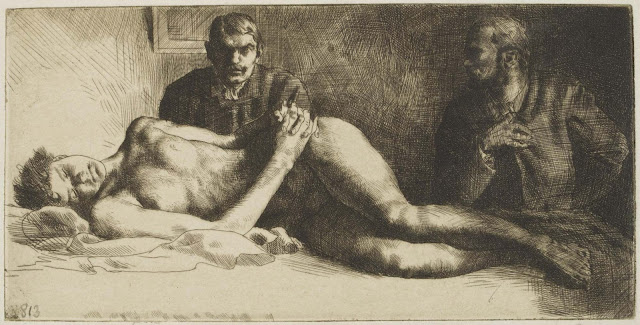 |
| William Strang Self-portrait no. 5 mezzotint 1885 British Museum |
 |
| William Strang Self-portrait no. 6 etching 1885 British Museum |
 |
| William Strang Self-portrait 1894 drawing British Museum |
 |
| William Strang Self-portrait no. 13 etching 1894 British Museum |
 |
| William Strang Self-portrait no. 15 etching, engraving 1895-96 British Museum |
 |
| William Strang Self-portrait no. 16 drypoint 1897 British Museum |
 |
| William Strang Self-portrait no. 17 drypoint 1898-1902 British Museum |
 |
| William Strang Self-portrait no. 18 drypoint 1910 British Museum |
 |
| William Strang The Model, after Rembrandt 1882 etching Victoria & Albert Museum |
William Strang (1859-1921) seems to have been intent throughout his career on inviting comparison between himself and Rembrandt. There was the series of shadowy self-portraits extending over many years. Several of those, taut with effort, are reproduced at top. In the sophisticated etching immediately above, William Strang placed himself in the position Rembrandt must have occupied in relation to the model when making the famous Reclining nude of 1658 (below) – Strang then rotating the viewpoint 180 degrees to show the model (and artist) from the front rather than from the back.
 |
| Rembrandt Reclining nude 1658 etching Metropolitan Museum gift of Louisine Havemeyer |
 |
| William Strang Study of a man's back 1896 engraving British Museum |
 |
| William Strang Studies of a workman 1904 drawing British Museum |
 |
| William Strang Lady Layard ca. 1885 mezzotint, etching British Museum |
 |
| William Strang Young Puritan 1885 mezzotint, etching British Museum |